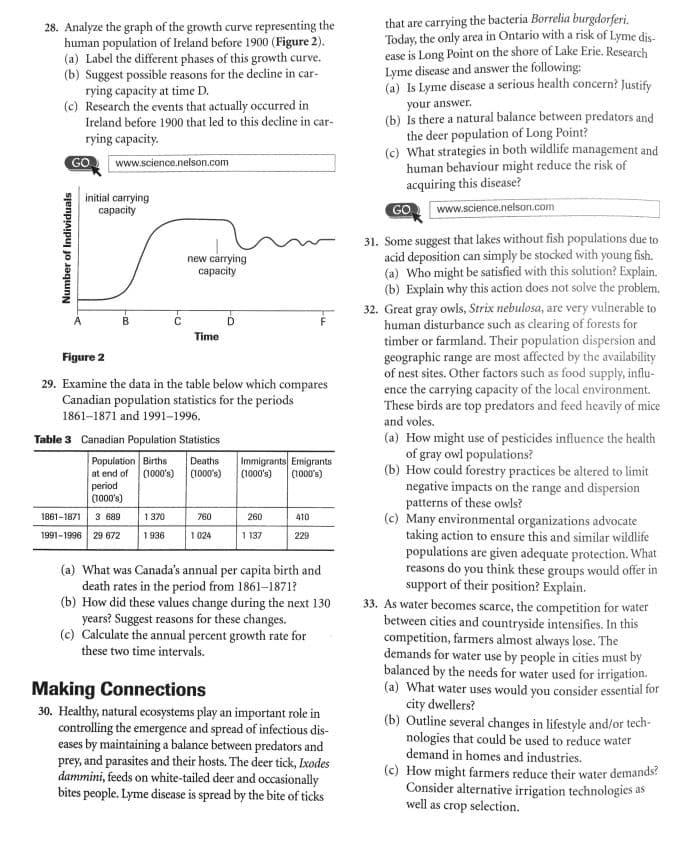33. As water becomes scarce, the competition for water between cities and countryside intensifies. In this competition, farmers almost always lose. The demands for water use by people in cities must by balanced by the needs for water used for irrigation. (a) What water uses would you consider essential for city dwellers? (b) Outline several changes in lifestyle and/or tech- nologies that could be used to reduce water demand in homes and industries. (c) How might farmers reduce their water demands? Consider alternative irrigation technologies as well as crop selection.
33. As water becomes scarce, the competition for water between cities and countryside intensifies. In this competition, farmers almost always lose. The demands for water use by people in cities must by balanced by the needs for water used for irrigation. (a) What water uses would you consider essential for city dwellers? (b) Outline several changes in lifestyle and/or tech- nologies that could be used to reduce water demand in homes and industries. (c) How might farmers reduce their water demands? Consider alternative irrigation technologies as well as crop selection.
Applications and Investigations in Earth Science (9th Edition)
9th Edition
ISBN:9780134746241
Author:Edward J. Tarbuck, Frederick K. Lutgens, Dennis G. Tasa
Publisher:Edward J. Tarbuck, Frederick K. Lutgens, Dennis G. Tasa
Chapter1: The Study Of Minerals
Section: Chapter Questions
Problem 1LR
Related questions
Question
pleas answer of 33

Transcribed Image Text:28. Analyze the graph of the growth curve representing the
human population of Ireland before 1900 (Figure 2).
(a) Label the different phases of this growth curve.
(b) Suggest possible reasons for the decline in car-
rying capacity at time D.
(c) Research the events that actually occurred in
Ireland before 1900 that led to this decline in car-
that are carrying the bacteria Borrelia burgdorferi.
Today, the only area in Ontario with a risk of Lyme dis-
ease is Long Point on the shore of Lake Erie. Research
Lyme disease and answer the following:
(a) Is Lyme disease a serious health concern? Justify
your answer.
(b) Is there a natural balance between predators and
the deer population of Long Point?
(c) What strategies in both wildlife management and
human behaviour might reduce the risk of
acquiring this disease?
GO
rying capacity.
GO
www.science.nelson.com
initial carrying
сарacity
www.science.nelson.com
31. Some suggest that lakes without fish populations due to
acid deposition can simply be stocked with young fish.
(a) Who might be satisfied with this solution? Explain.
(b) Explain why this action does not solve the problem.
32. Great gray owls, Strix nebulosa, are very vulnerable to
human disturbance such as clearing of forests for
timber or farmland. Their population dispersion and
geographic range are most affected by the availability
of nest sites. Other factors such as food supply, influ-
ence the carrying capacity of the local environment.
These birds are top predators and feed heavily of mice
and voles.
new carrying
сарacity
A
Time
Figure 2
29. Examine the data in the table below which compares
Canadian population statistics for the periods
1861–1871 and 1991-1996.
(a) How might use of pesticides influence the health
of gray owl populations?
(b) How could forestry practices be altered to limit
negative impacts on the range and dispersion
patterns of these owls?
(c) Many environmental organizations advocate
taking action to ensure this and similar wildlife
populations are given adequate protection. What
reasons do you think these groups would offer in
support of their position? Explain.
33. As water becomes scarce, the competition for water
between cities and countryside intensifies. In this
competition, farmers almost always lose. The
demands for water use by people in cities must by
balanced by the needs for water used for irrigation.
(a) What water uses would you consider essential for
city dwellers?
(b) Outline several changes in lifestyle and/or tech-
nologies that could be used to reduce water
demand in homes and industries.
(c) How might farmers reduce their water demands?
Consider alternative irrigation technologies as
well as crop selection.
Table 3 Canadian Population Statistics
Population Births
at end of
period
(1000's)
Deaths
(1000's)
Immigrants Emigrants
(1000's)
(1000's)
(1000's)
1861-1871
3 689
1 370
760
260
410
1991-1996 29 672
1936
1 024
1 137
229
(a) What was Canada's annual per capita birth and
death rates in the period from 1861–1871?
(b) How did these values change during the next 130
years? Suggest reasons for these changes.
(c) Calculate the annual percent growth rate for
these two time intervals.
Making Connections
30. Healthy, natural ecosystems play an important role in
controlling the emergence and spread of infectious dis-
eases by maintaining a balance between predators and
prey, and parasites and their hosts. The deer tick, Ixodes
dammini, feeds on white-tailed deer and occasionally
bites people. Lyme disease is spread by the bite of ticks
Number of Individuals
Expert Solution
This question has been solved!
Explore an expertly crafted, step-by-step solution for a thorough understanding of key concepts.
Step by step
Solved in 2 steps

Recommended textbooks for you

Applications and Investigations in Earth Science …
Earth Science
ISBN:
9780134746241
Author:
Edward J. Tarbuck, Frederick K. Lutgens, Dennis G. Tasa
Publisher:
PEARSON

Exercises for Weather & Climate (9th Edition)
Earth Science
ISBN:
9780134041360
Author:
Greg Carbone
Publisher:
PEARSON

Environmental Science
Earth Science
ISBN:
9781260153125
Author:
William P Cunningham Prof., Mary Ann Cunningham Professor
Publisher:
McGraw-Hill Education

Applications and Investigations in Earth Science …
Earth Science
ISBN:
9780134746241
Author:
Edward J. Tarbuck, Frederick K. Lutgens, Dennis G. Tasa
Publisher:
PEARSON

Exercises for Weather & Climate (9th Edition)
Earth Science
ISBN:
9780134041360
Author:
Greg Carbone
Publisher:
PEARSON

Environmental Science
Earth Science
ISBN:
9781260153125
Author:
William P Cunningham Prof., Mary Ann Cunningham Professor
Publisher:
McGraw-Hill Education

Earth Science (15th Edition)
Earth Science
ISBN:
9780134543536
Author:
Edward J. Tarbuck, Frederick K. Lutgens, Dennis G. Tasa
Publisher:
PEARSON

Environmental Science (MindTap Course List)
Earth Science
ISBN:
9781337569613
Author:
G. Tyler Miller, Scott Spoolman
Publisher:
Cengage Learning

Physical Geology
Earth Science
ISBN:
9781259916823
Author:
Plummer, Charles C., CARLSON, Diane H., Hammersley, Lisa
Publisher:
Mcgraw-hill Education,